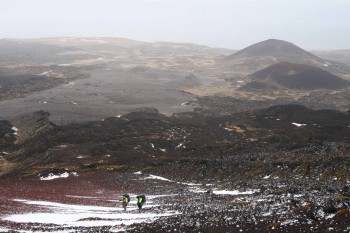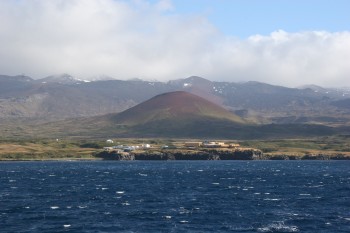
Marion’s research station, with Junior’s Kop and the snow-covered island interior
Photograph by Tara van Niekerk
Marion Island is the larger of the two Prince Edward Islands. The South African island group is a Ramsar Wetland of International Importance – the first for the sub-Antarctic Region. Both islands have Special Nature Reserve status, the highest level of protection that can be afforded by statutory measures in South Africa. No tourism is allowed on the island but it serves as a “living laboratory” hosting a number of research programmes. Long-term albatross and petrel monitoring programmes have been running at Marion Island since the 1970s (click here). In 2013 a Marine Protected Area was declared in the waters surrounding the island group. A revision of the islands’ first management plan, published in 1996, awaits implementation.
Marion’s eastern coastal plain from the scoria slopes of First Red Hill
The central highland of the island is separated from the coastal plain by a steep escarpment, with conical hills of volcanic ash and scoria dotting the landscape.
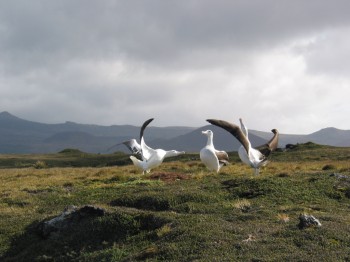
Courting Wandering Albatrosses on Marion's coastal plain
The island hosts eight ACAP-listed species. Threats include by-catch mortality in long-line fisheries, changes in prey availability due to over-fishing and changing oceanographic conditions (such as an increase in sea temperature of 1.4°C over a 30-year period). Almost half of the World’s Wandering Albatrosses Diomedea exulans breed at the Prince Edward Islands. Although the population declined by 2% from 1998 to 2005, the trend seems to have reversed in recent years.
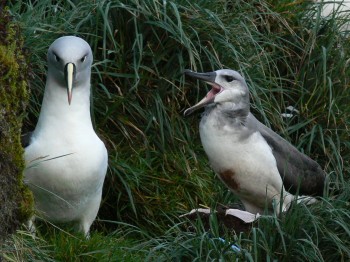
A Grey-headed Albatross chick begs for a meal...
Grey-headed Albatrosses Thalassarche chrysostoma breed on cliffs on the south side of the island. Recent data suggest that the population is stable. They can cover huge distances at sea; recorded travelling as far as 4000 km, with trips of up to 18 000 km.
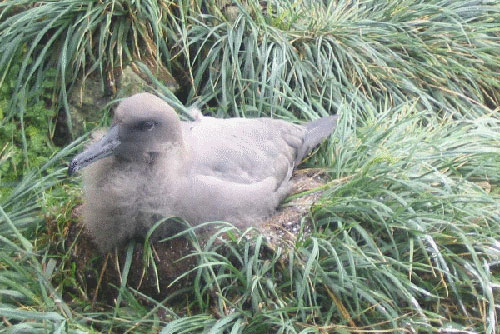
...while a Sooty Albatross chick awaits its own meal on its cliff-side nest
The ACAP-listed species of greatest concern at Marion Island is the Sooty Albatross Phoebetria fusca. A decrease in numbers (23% of the global population) began in the early 1980s and since 1996 the population has decreased by almost 2% a year. In contrast Light-mantled Sooty Albatrosses P. palpebrata have increased by nearly 6% a year since 1996. In 2011, a satellite-tracked bird circumnavigated the Southern Ocean in 188 days.
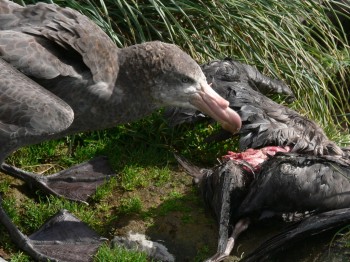
A Northern Giant Petrel preys upon a Sooty Albatross chick
Photographs by Marienne de Villiers unless stated
Southern Giant Petrels Macronectes giganteus are colonial breeders usually near penguin and seal congregations. Northern Giant Petrels M. halli breed inland, usually solitarily against rock outcrops. On Marion Island, Northern Giant Petrels have been recorded preying on chicks of Wandering, Grey-headed and Sooty Albatrosses. The numbers of both Macronectes species on Marion Island are stable. White-chinned Procellaria aequinoctialis and Grey P. cinerea Petrels also breed on Marion Island.
Selected References:
Crawford, R.J.M., Cooper, J., Dyer, B.M., Greyling, M.D., Klages, N.T.W., Ryan, P.G., Petersen, S.L., Underhill, L.G., Upfold, L., Wilkinson, W., de Villiers, M.S., du Plessis, S., Du Toit, M., Leshoro, T.M., Makhado, A.B., Mason, M.S., Merkle, D., Tshingana, D., Ward, V.L. & Whittington, P.A. 2003. Populations of surface-nesting seabirds at Marion Island, 1994/5-2002/3. African Journal of Marine Science 25: 427-440.
de Villiers, M.S. & Cooper, J. 2008. Conservation and management. In: Chown, S.L. & Froneman, P.W. (Eds). The Prince Edward Islands: Land-Sea Interactions in a Changing Ecosystem. Stellenbosch: Sun PReSS. pp. 113-131.
de Villiers, M.S., Chown, S.L. & Cooper, J. 2011. Prince Edward Islands Conservation Handbook. Stellenbosch: SUN PRESS. 80 pp.
Dilley, B., Davies, D., Connan, M., Cooper, J., de Villiers, N, Swart, L., Vandenebeele, S., Ropert-Coudert, Y. & Ryan, P.G. 2013. Giant petrels as predators of albatross chicks. Polar Biology 36: 761-766.
Lombard, A.T., Reyers, B., Schonegevel, L.Y., Cooper, J., Smith-Adao, L.B., Nel, D.C., Froneman, P.W., Ansorge, I.J., Bester, M.N., Tosh, C.A., Strauss, T., Akkers, T., Gon. O., Leslie, R.W. & Chown, S.L. 2007. Conserving pattern and process in the Southern Ocean: designing a Marine Protected Area for the Prince Edward Islands. Antarctic Science 19: 39-54.
Nel, D.C., Nel, J.C., Ryan, P.G., Klages, N.T.W., Wilson, R.P. & Robertson, G. 2000. Foraging ecology of Grey-headed Mollymawks at Marion Island, southern Indian Ocean, in relation to longline fishing activity. Biological Conservation 96: 219-231.
Nel, D.C., Ryan, P.G., Nel, J.L., Klages, N.T.W., Wilson, R.P., Robertson, G., et al. 2002. Foraging interactions of Wandering Albatrosses Diomedea exulans breeding on Marion Island with long-line fisheries in the southern Indian Ocean. Ibis 144: 141-154.
Prince Edward Islands Management Plan Working Group 1996. Prince Edward Islands Management Plan. Pretoria: Department of Environmental Affairs & Tourism. 64 pp.
Ryan, P.G., Dilley, B.J. & Jones, M.G.W. 2012. The distribution and abundance of white-chinned petrels (Procellaria aequinoctialis) breeding at the sub-Antarctic Prince Edward Islands. Polar Biology 35: 1851-1859.
Ryan, P.G., Jones, M.G.W., Dyer, B.M., Upfold, L. & Crawford, R.J.M. 2009. Recent population estimates and trends in numbers of albatrosses and giant petrels breeding at the sub-Antarctic Prince Edward Islands. African Journal of Marine Science 31: 409-417.
Terauds, A., Cooper, J., Chown, S.L. & Ryan, P. 2010. Marion and Prince Edward. Africa’s Southern Islands. Stellenbosch: SUN PReSS. 176 pp.
Marienne de Villiers, Animal Demography Unit, Department of Zoology, University of Cape Town, 26 April 2013

 English
English  Français
Français  Español
Español 